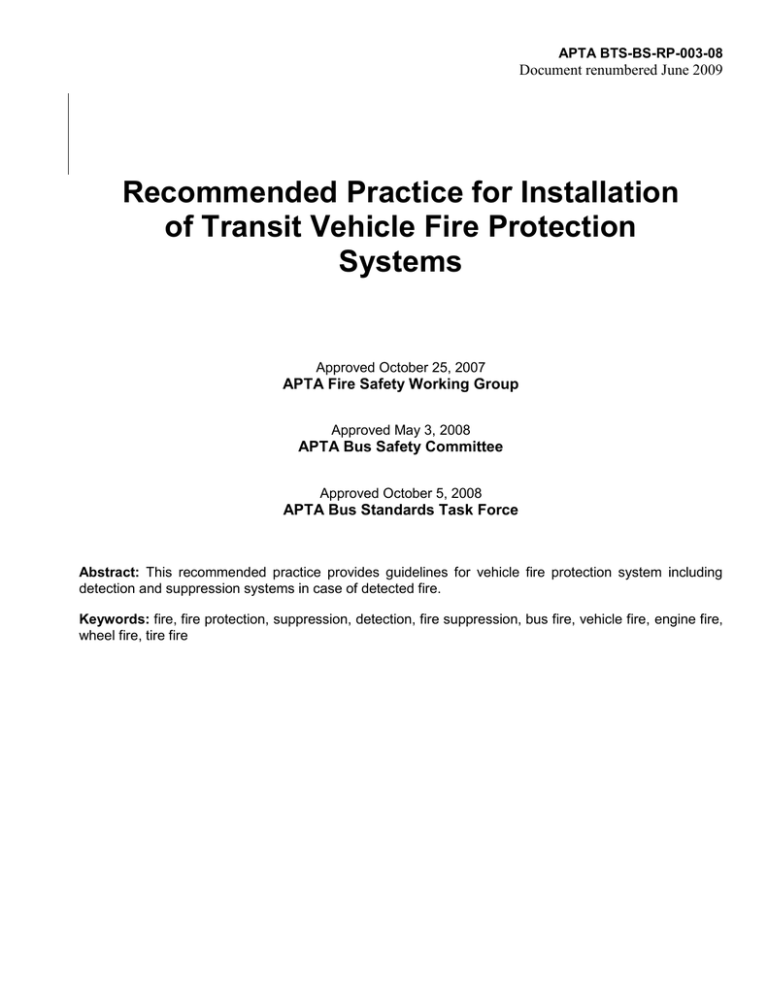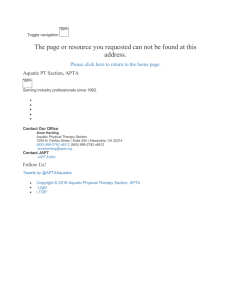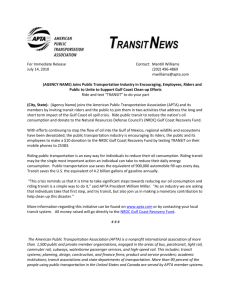
APTA BTS-BS-RP-003-08
Document renumbered June 2009
Recommended Practice for Installation
of Transit Vehicle Fire Protection
Systems
Approved October 25, 2007
APTA Fire Safety Working Group
Approved May 3, 2008
APTA Bus Safety Committee
Approved October 5, 2008
APTA Bus Standards Task Force
Abstract: This recommended practice provides guidelines for vehicle fire protection system including
detection and suppression systems in case of detected fire.
Keywords: fire, fire protection, suppression, detection, fire suppression, bus fire, vehicle fire, engine fire,
wheel fire, tire fire
APTA BTS-BS-RP-003-08
Document renumbered June 2009
Introduction
(This introduction is not a part of APTABTS-BS-RP-003-08, Recommended Practice for Installation of Transit Vehicle Fire
Protection Systems.)
This Recommended Practice for Installation of Transit Vehicle Fire Protection Systems reflects the
consensus of the APTA Bus Standards Program members on the items, methods, and procedures that have
provided the best practice based on the experiences of those present and participating in meetings of the
Program Task Forces and Working Groups. Recommended practices are voluntary, industry-developed,
and consensus-based practices that assist equipment suppliers, vehicle and component manufacturers, and
maintenance personnel in the construction, assembly, operation, and maintenance of transit bus vehicles.
Recommended practices may include test methodologies and informational documents. Recommended
practices are non-exclusive and voluntary; they are intended to neither endorse nor discourage the use of
any product or procedure. All areas and items included herein are subject to manufacturers’ supplemental
or superseding recommendations. APTA recognizes that for certain applications, the practices, as
implemented by operating agencies, may be either more or less restrictive than those given in this
document.
This recommended practice provides guidelines for transit bus fire suppression systems in conjunction
with a vehicle fire.
APTA recommends the use of this recommended practice by:
Individuals or organizations that inspect and maintain transit buses
Individuals or organizations that develop specifications for transit buses
Individuals or organizations that build or manufacturer fire suppression systems
Individuals or organizations that contract with others for the inspection and maintenance of transit buses
Individuals or organizations that influence how transit buses are inspected and maintained
Test results must meet or exceed federal, state, or other local regulatory agency requirements if different
from the recommendations outlined in this document.
Participants
The American Public Transportation Association (APTA) greatly appreciates the contributions of the
Bus Transit Standards Bus (Fire) Safety Working Group, who provided the primary effort in drafting
the Recommended Practice for Transit Bus Installation of Transit Vehicle Fire Protection Systems.
Copyright © 2009 APTA. All rights reserved.
APTA BTS-BS-RP-003-08
Document renumbered June 2009
Recommended Practice for Installation of Transit Vehicle
Fire Protection Systems
1. Overview
This document establishes a recommended practice for installation of transit vehicle fire protection
systems. Individual operating agencies may modify these guidelines to accommodate their specific
equipment and mode of operation.
Fire protection system includes a fire detection system which may or may not include a fire suppression
system.
This practice is to be used in addition to the fire protection equipment manufacturer’s installation
recommendations.
1.1 Scope
This recommended practice applies to the installation of a fire protection system on heavy duty transit
vehicles and over the road coaches. This document is not inclusive of systems installed on small transit
vehicles such as cutaways and vehicles used in paratransit. Vehicles used in paratransit may require
additional design consideration above and beyond this document.
1.2 Purpose
The purpose of this recommended practice is to define the minimum performance requirements for
detection of and suppression of thermal events on transit vehicles. The resulting fire protection system
shall be capable of detecting and minimizing potential damage of fire events in those zones of the vehicle
identified in this document.
2. References
This guideline is to be used in conjunction with the original equipment manufacturer (OEM), fire
protection equipment manufacturer service manuals and any authorities having regulatory jurisdiction. It
is the responsibility of the user of this document to reconcile any discrepancies or conflicts that may arise
between these guidelines, manuals and applicable codes or regulations.
NFPA, SAE, NEC, DOT,
BT-RP-007-05, Bus Shutdown
Copyright © 2009 APTA. All rights reserved.
APTA BTS-BS-RP-003-08
Document renumbered June 2009
3. Definitions, abbreviations, and acronyms
For the purposes of this guideline, the following terms, definitions, abbreviations, and acronyms apply.
3.1 Definitions
3.1.1 Original equipment manufacturer is the vehicle manufacturer.(this document only)
3.1.2 Listed : Equipment, materials or services included in a list published by an organization that is
acceptable to the authority having jurisdiction and concerned with product evaluation, that maintains
periodic inspection of production labeled equipment or materials, and by whose labeling the
manufacturer indicated compliance with appropriate standards or performance in a specified manner.
3.1.3 Transit Vehicle: A transit operated heavy-duty vehicle used in transit or over the road service
with the exception of vehicles used in paratransit service.
3.1.4 Fire Protection: Fire detection system with or without a fire suppression system.
3.1.5 Fire Suppression: A system designed to suppress or mitigate damage from a fire.
3.1.6 Pilot vehicle: First article of an order.
3.1.7 Zones: Location within the vehicle
Zone 1 Engine compartment
Zone 2 Exhaust Systems (external to engine compartment)
Zone 3 Battery
Zone 4 Wheel Well
Zone 5 HVAC Compartment
Zone 6 Operator’s Work Station
Zone 7 Articulated Turn Table
Zone 8 Fuel Storage (inclusive of roof mounted hybrid battery)
Zone 9 Electrical Junction Boxes
Zone 10 Interior
3.2 Abbreviations and acronyms
HVAC Heating Ventilation Air Conditioning System
OEM Original Equipment Manufacturer
AFSS Automatic Fire Suppression System
Copyright © 2009 APTA. All rights reserved.
APTA BTS-BS-RP-003-08
Document renumbered June 2009
3.3 Potential Causes of Fire or Ignition Sources for Each Zone
Zone 1
Engine Compartment - electrical, combustible or flammable liquids/solids/gases, hot
surfaces, belts, clutches, turbo fire, ignition of exhaust blankets, catalytic converter,
particulate diesel filter/trap
Zone 2
Exhaust Systems (external to engine compartment) – high temperatures, exhaust leak, tail
pipe fire, ignition of exhaust blankets, catalytic converter, particulate diesel filter/trap, and
monitoring systems
Zone 3
Low Voltage Battery – electrical, flammable liquids/solids/gases, cables, equalizers, circuit
breakers, fusible link malfunction, corrosion, overcharge, battery box
Zone 4
Wheel well – under inflated tire, overheated bearings, leaky wheel seal, flammable
liquids/solids, high heat in brake area, road debris
Zone 5
HVAC Compartment – electrical, flammable liquids/solids/gases, high heat
Zone 6
Operator’s Work Station – electrical, flammable liquids/solids/gases, high heat, tobacco
smoking, debris build up
Zone 7
Articulated Turn Table – friction, debris build up, electrical cabling, vandalism, tobacco
smoking
Zone 8
Fuel Storage/High Voltage Energy Storage – Fuel leaks, arcing, debris, flammable
liquids/solids/gases, cables, equalizers, circuit breakers, fusible link malfunction, corrosion,
overcharge
Zone 9
Electrical Junction Boxes – shorts, electrical, flammable liquids/solids, cables, equalizers,
circuit breakers, fusible link malfunction, corrosion, chaffing
Zone 10
Interior – tobacco smoking, debris, HVAC duct, fluorescent light ballast, corrosion,
cabling, chaffing, signage, wire harnesses, vandalism, advertisements
4. Fire Detection System
4.1 Sensors
There are two basic sensor devices that are used to provide early warning of fires. Thermal sensors detect
heat and optical sensors detect flame.
4.1.1 Thermal Sensors:
Three common thermal sensors utilized in transit applications are
Fixed Temp: A thermal sensor detects heat above a given set point
Rate of Rise: A thermal sensor detects a rapid rise
Linear Thermal: A wire or tube that detects heat
Copyright © 2009 APTA. All rights reserved.
APTA BTS-BS-RP-003-08
Document renumbered June 2009
4.1.2 Optical Sensors:
An optical flame sensor detects the energy produced by a flame and must be suitable for the operating
environment of a transit vehicle.
4.1.3 Recommended Sensor Technology
Vehicle configurations vary, it is recommended that the detection system be designed based on a transit
property’s specific configuration in consultation with the OEM and AFSS supplier. .
Location
Historical
Frequency
Base Line
Enhanced = baseline + _____
Zone 1
High
Mix of thermal sensors and optical infrared sensor
Zone 2
High
Zone 3
Zone 4
Medium
High
4 spot thermal or equivalent length of linear
thermal
System that provides early warning of over heat
conditions that would alert driver to minimize
potential for combustion.
No baseline sensor protection.
No baseline sensor protection.
Zone 5
Medium
No baseline sensor protection.
Low
No baseline sensor protection.
Zone 6
Zone 7
Low
Low
Zone 8
Low
Low
Zone 9
Low
Consult with OEM & AFSS supplier to further address
individual transit concerns
1 spot thermal or equivalent length of linear thermal
Any system that includes sensors to provide early warning
of over heat conditions that would alert driver to minimize
potential for combustion. Consult with OEM, AFSS &
brake suppliers to further address individual transit
concerns or identify emerging technologies.
Consult with OEM & AFSS supplier to further address
individual transit concerns
Consult with OEM & AFSS supplier to further address
individual transit concerns
Low
Zone 10
Medium
Medium
4.2 Display and/or Control Panel
4.2.1 System Controls
A control panel should be provided for all detection and/or suppression systems. The control panel should
provide, at a minimum, electrical supervision of system power and detection; and system actuation wiring
circuits if so equipped. The control panel should be visible and accessible to the seated driver/operator.
It is recommended that a separate manual means of activation of the suppression system be provided
regardless of availability of system power. Manual actuators shall include operating instructions and shall
be located within easy view and reach of the vehicle operator without requiring movement from the
normal seated position. The manual actuator shall have a protected device to avoid accidental activation
(guard, pin etc.). They should require a minimal amount of force or movement to activate and in no case
more than 40lbs of force or movement no more than 14in to secure operation. A means of remotely
Copyright © 2009 APTA. All rights reserved.
APTA BTS-BS-RP-003-08
Document renumbered June 2009
monitoring the agent cylinder pressure is available if desired.
4.2.2 Alarm and Signal
At a minimum the system control panel should include an alarm and signal system. Both a fire and a fault
should activate a visual and audible alarm.
Lights:
System OK light: (Green)
Fault/Trouble light: (Yellow)
Fire Indicator: (Red)
Audible Alarm:
Detection or fault.
Means shall be provided to silence the alarm.
Distinct and recognizable by the operator.
4.3 Wiring, Cabling and Connectors
All lines, wiring, hoses, cables, and lines must be properly bracketed, insulated, and isolated to avoid
chaffing and to protect against heat sources, using heat shields. Wiring should be routed to avoid damage
from abrasion pinch points, heat, road debris, excessive stretching and damage from the exhaust system
and turbo charger. Engine component connections should be water proofed or shielded to prevent the
intrusion of moisture. UL listed or equivalent wire for fire suppression system applications must be used.
4.4 Auxiliary Outputs
Auxiliary outputs may be required to meet the requirements of APTA BS-RP-008-05 Recommended
Practice for Transit Bus Fire Safety Shutdown for additional information.
4.5 Power Requirements/Options
Baseline: Power for the fire protection system shall be provided by the bus electrical system directly from
the vehicle battery terminals or through dedicated power and ground buss bars. Nominal power
consumption of the system should not exceed 300mA. If the system is connected to the switched side of a
battery disconnect switch, system performance may be compromised when the switch is in the off
position.
Enhanced: A battery-backup system may be used to provide limited-to-full system functionality in the
event primary system power is interrupted.
5. Fire Suppression Systems
In addition to all of the above requirements, the following components are required for an integrated
Copyright © 2009 APTA. All rights reserved.
APTA BTS-BS-RP-003-08
Document renumbered June 2009
detection and suppression system. Integrated systems must be approved by an accredited third party.
5.1 Storage Containers
Stored-pressure type containers shall be designed to meet the requirements of the U.S. Department of
Transportation (DOT) and Transport Canada (TC).
Containers shall be corrosion resistant.
Each container shall have an indicator (pressure gauge) to show that it is in a ready condition or in need of
recharging. The gauge should be readily visible to an operator during a pre-trip inspection with out the use
of tools. In the event that the gauge is inaccessible remote monitoring is acceptable.
Containers may be mounted in interior or exterior locations provided the location will not exceed the
manufacturer’s operating temperatures or be subject to excessive environmental extremes.
5.2 Distribution System
Distribution system should be designed and approved in accordance within the AFSS manufacture’s
design and installation parameters.
5.3 Nozzles
Quantity, location and orientation of nozzles shall be in accordance with AFSS design specifications and
determination of hazard zones to be protected. A typical installation has a minimum of three nozzles
protecting an engine compartment.
Nozzles should be mounted in such a fashion that normal maintenance practices do not require the
removal or adjustment of any system discharge nozzle.
Discharge nozzles shall be provided with blow-off caps or other suitable devices or materials to prevent
the entrance of moisture or other environmental materials into the distribution piping. The protective
device shall blow off, open or out upon agent discharge.
5.4 Suppression Agent
The amount and type of suppression agent shall be determined based on a transit property’s specific
configuration in consultation with the OEM and AFSS supplier. The typical installation for a Zone 1
(engine compartment) is 20-25 pounds of dry chemical or equivalent. Due diligence should be applied to
atypical installations utilizing alternative agents.
6. Certifications
The system design and pilot vehicle installation shall be reviewed and approved by the AFSS
manufacturer in accordance with their requirements. A copy of the written approval must be provided to
the procurement agency.
Copyright © 2009 APTA. All rights reserved.
APTA BTS-BS-RP-003-08
Document renumbered June 2009
Any modification that may effect the performance of the AFSS shall require
recertification by the AFSS supplier.
Copyright © 2009 APTA. All rights reserved.


